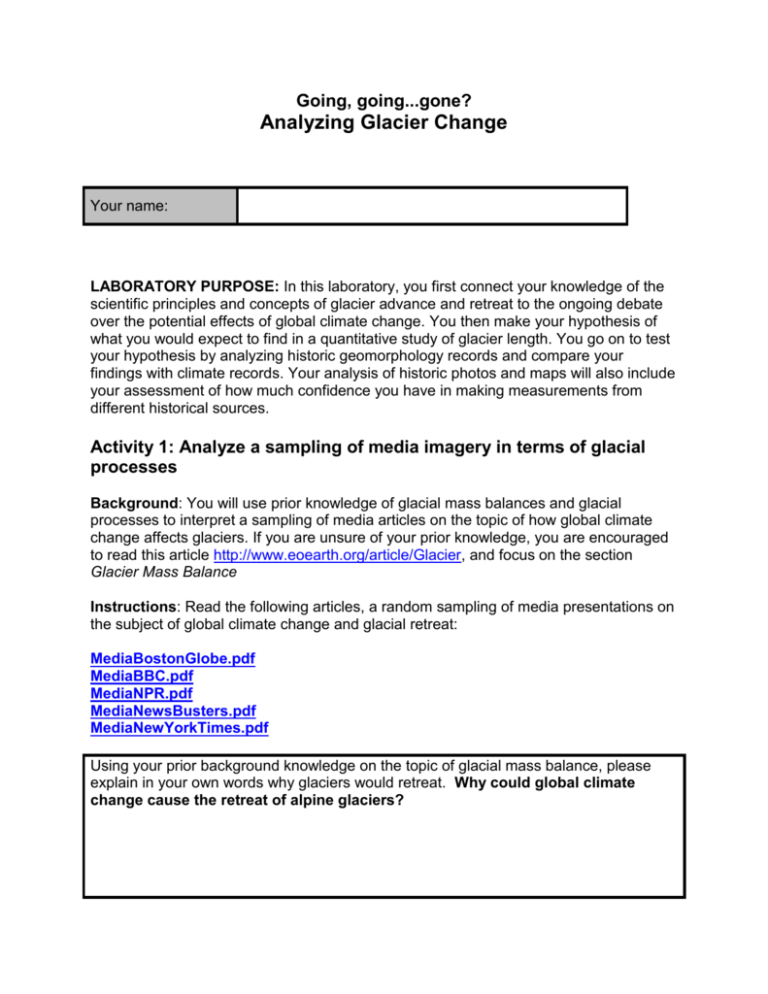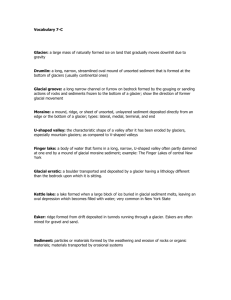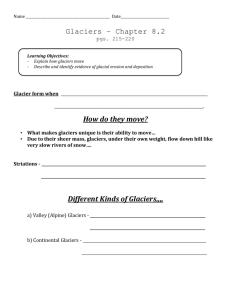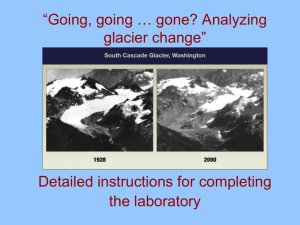glacial
advertisement

Going, going...gone? Analyzing Glacier Change Your name: LABORATORY PURPOSE: In this laboratory, you first connect your knowledge of the scientific principles and concepts of glacier advance and retreat to the ongoing debate over the potential effects of global climate change. You then make your hypothesis of what you would expect to find in a quantitative study of glacier length. You go on to test your hypothesis by analyzing historic geomorphology records and compare your findings with climate records. Your analysis of historic photos and maps will also include your assessment of how much confidence you have in making measurements from different historical sources. Activity 1: Analyze a sampling of media imagery in terms of glacial processes Background: You will use prior knowledge of glacial mass balances and glacial processes to interpret a sampling of media articles on the topic of how global climate change affects glaciers. If you are unsure of your prior knowledge, you are encouraged to read this article http://www.eoearth.org/article/Glacier, and focus on the section Glacier Mass Balance Instructions: Read the following articles, a random sampling of media presentations on the subject of global climate change and glacial retreat: MediaBostonGlobe.pdf MediaBBC.pdf MediaNPR.pdf MediaNewsBusters.pdf MediaNewYorkTimes.pdf Using your prior background knowledge on the topic of glacial mass balance, please explain in your own words why glaciers would retreat. Why could global climate change cause the retreat of alpine glaciers? Activity 2: Point and Counterpoint Instructions: In this activity, you read two different articles discussing the retreat and advance of glaciers. Whereas Pelto presents the case for ongoing glacial retreat, Hecht argues that we should prepare for another ice age because the glaciers are growing and advancing. HectAdvance.pdf PeltoRetreat.pdf After reading each article, please finish a scientific hypothesis for what Hecht and Pelto would expect to find if they examined 150 years of historical records of maps and photos of one glacial system in the Cascades of the Pacific Northwest USA. Hecht Hypothesis: A glacial system in the Cascades of the Pacific Northwest USA has been ... Pelto Hypothesis: A glacial system in the Cascades of the Pacific Northwest USA has been ... Background to this question: You understand that scientists make hypotheses and (supposedly) test them objectively, ideally not caring whether the hypothesis is supported or falsified by data and data analysis. Science, geomorphology included, can never “prove” that a hypothesis is true; that is for faith. Thus, in science, results and analysis can only support a hypothesis, not support (falsify) a hypothesis, or neither support nor not support a hypothesis. You will now make a hypothesis for what you would expect to find by examining 150 years of historical records of a glacial system in the Cascades of the Pacific Northwest USA. The first sentence of your hypothesis that you write should explain whether you think you would predict glacier retreat, glacier advance, or some combination. The second sentence of your hypothesis will explain the reason for your first hypothesis. The source of the second part of your hypothesis can be a hunch, an intuition, or it can be based on prior readings. What is your hypothesis? Finish the two sentences: I hypothesize that, over the last 150 years, ... I also hypothesize that this has been caused by ... Activity 3: Testing your hypotheses by examining maps and photos of the Nisqually Glacier, Mount Rainier Background: Glacial geomorphologists use many different types of data to analyze how glaciers change. Some make direct measurements of glaciers in the field. Others use satellites to monitor changes. A very common strategy is to make repeat observations over time, using maps and historical photographs. This website provides you a summary of some of the methods that have been used to study glacier change on Mount Rainier: http://www.glaciers.pdx.edu/MRNP/Res00.html Instructions: In this activity, you will test your hypothesis analyzing a mixture of historical maps and photographs of the Nisqually Glacier on Mount Rainier, as well as different temperature records. Task 1. Estimate the length of the Nisqually Glacier, starting at the Summit of Mount Rainier. Nisqually Glacier Length Data Instructions: -- Use the map and photographs (linked on the webpage version of this assignment) to estimate the length of the Nisqually Glacier of Mount Rainier. o In the 1856 map, you will need to use the scale bar to estimate the glacier’s length. The map is fuzzy, so just do your best. o In the 1917, 1924, 1994, and 1997 maps (and the 1983 aerial photograph), you will estimate the distance to the road (bridge) that crosses the Nisqually River and then subtract that distance from the 8.8 kilometer estimate of the distance from the summit of Mount Rainier to the bridge. Look at the 1971 map for an example. o In all of the other photographs, you will be making your best estimate (guess) of the position, looking at the surrounding features on the photos and comparing them with the topographic map. -- In the Your Confidence column, please indicate your confidence level of your estimate, from high (put number 1) to very low (put number 4). You will have to answer questions in the next task related to your confidence and the ability to make interpretations later. Data Table of Nisqually Glacier Length. Use the linked map and photo sources to estimate the length of the Nisqually Glacier in different time periods. Instructions: Fill in the blanks in this data table. Year Source (and link) 1856 Map 1907 Map 1917 Map 1924 1929 1940 1943 1951 1956 1958 1960 1966 1969 1971 1983 1994 1997 2003 Map Ground Photo Ground Photo Ground Photo Ground Photo Ground Photo Ground Photo Aerial Photo Ground Photo Ground Photo Map Aerial Photo Map Map Aerial Photo Your Confidence (high-1, medium-2, low3, very low-4) Distance in Kilometers from Nisqually River Bridge to terminus of Nisqually Glacier (round up to the nearest 0.1 km) Note: Bridge not present, so you will have to estimate the length from the map and the scale bar At the bridge Length of Nisqually Glacier in Kilometers (subtract distance from bridge from 8.8 kilometer distance from summit of Mount Rainier) ____________ Note: you will have to measure in miles and convert to km by multiplying miles times 1.6. The scale bar has increments of 1/4 mile 8.8 km ____________ Note: you will have to measure in miles and convert to km by multiplying miles times 1.6. 1.9 km 6.9 km 1.4 km 7.4 km Task 2. Analyzing uncertainty. You gave your opinion regarding your confidence in the Nisqually Glacier length. You probably put a 1 for the values that were already entered in the table. You may have put a 4 down for many of the ground photos, where you found it very difficult to estimate the position of the terminus. Explain your confidence ranking. The answer does not have to be detailed, but your answer must be based on your observations of looking at the maps and photos. Task 3. Plot your data of glacier length on NisquallyGraph.jpg. This is the graph of Nisqually Glacier Length vs Year. For your convenience, the different dates on the maps and photos are indicated on the X axis with a triangle. An electronic version of this graph is linked on the webpage version of this assignment here: NisquallyGraph.jpg Instructions: Using the data entries in the table you created, plot the length of the Nisqually Glacier (in kilometers) on this timeline. For your convenience, the dates are indicated on the X axis with a triangle. Then, after you have plotted the data points, connect them. You do this by drawing a line between the points. HOWEVER, DO NOT CONNECT THE DATA POINTS WHERE YOU HAVE LOW OR VERY LOW CONFIDENCE. ONLY CONNECT THE DATA POINTS WHERE YOU HAVE A MEDIUM OR HIGH CONFIDENCE OF YOUR LENGTH ESTIMATE. In other words, draw the lines directly between only those data where you have a medium or high confidence. The goal is for you to see all of your data, but create a curve only from data that you consider more reliable. Example: After gathering data from a different glacier at Mount Rainier, the following graph presents a plot of the raw data. In the case of Glacier X, the raw data suggest that the glacier front receded from 1856 until the mid-1960s. Since then, Glacier X appears to have advanced, retreated and then advanced. Not all of these data points had "high" or "medium" confidence. By "high" confidence, I felt that the position of the terminus was well within the request to measure to the closet 0.1 kilometers (100 meters). By "medium" confidence, I felt that the position of the terminus on the map or photograph could be established pretty closely to within 100 meters (0.1km) or 200 meters (0.2 km). By "low" confidence, I felt that I had some general idea of locating the terminus within a few hundred meters, but I really didn't know where to put the estimate within a broad area, so I selected the middle point of several hundred meters. By "very low", my judgment of where to place the terminus was based on maybe one or two possible matches between a feature on the ground photograph and the topographic map. Thus, when I connected the different terminus positions, I only connected those data points with a medium and high confidence. You do not have to put arrows for the points of low and very low confidence. I just did this to emphasize that you will not use these low confidence points in making a trend line. Task 4. Comparing your curve to atmosphere temperature records. Background: The graphs below show different temperature trends. The upper graph shows some common global compilations that are often seen in the popular press in different forms. The lower graph shows the mean annual temperature of the Puget Sound through dots, where the line represents one way to calculate the general 20 th century trend. This task has you accept these temperature trends, for now, and think about how your record of glacier length compares with these trends. Different Global Annual Temperature Trend (higher is warmer): Puget Sound Annual Temperatures (with line showing the general trend): Example: For my plot of "Glacier X" at Mount Rainier...this is an example answer to the next question... Are there similarities and differences between the plot of "Glacier X" glacier length and Global Temperature? Puget Sound Temperature? Using only the "Glacier X" trend line with points of high and medium confidence, there does appear to be a reasonable match between warming global temperatures between 1913-2000 and the recession of Glacier X. The slight advance around 1980, however, does not match the global temperature curve. The same holds true for the gradual trend of Puget Sound warming and the recession of "Glacier X". Since the temperature plot of Puget Sound seemed to have a lot of scatter, I feel comfortable speculating about my points of low and very low confidence. I hypothesize that the lowconfidence glacier advance in the 1980s might relate to the cooler years in the early 1980s in the Puget Sound. Instructions: Now, you answer the questions below for your graph of the Nisqually glacier length. Are there similarities and differences between your plot of Nisqually glacier length and Global Temperature? Puget Sound Temperature? [Keep in mind that your glacier length plot and this temperature record go in different directions, where cooler temperatures typically product longer glaciers.] Please identify similarities and differences that you see. Task 5. Comparing your curve to other glacier length records. The graph below is a reconstruction of temperature change based on glacier length records by J. Oerlemans, published in Science. In other words, the changes in glacier length was used to estimate temperature change in different regions (different colors) and then globally. For example, the light blue line uses a combination of different glacier lengths in the Pacific Northwest (including the Nisqually Glacier) to reconstruct temperature. What are the similarities and differences between your plot of Nisqually glacier length and J. Oerleman’s calculation for the Pacific Northwest? [Keep in mind that your glacier length plot and this temperature record go in different directions, where cooler temperatures typically product longer glaciers.] Do you think that you would have a greater confidence in your interpretations if you had a greater degree of confidence in all of the raw data? If so, explain why. If not, explain why. Activity 4: Comparing your study with other glaciers in the western USA Instructions: In this activity, you will select 2 glaciers in the American West and analyze changes. You will use glaciers presented on this website: http://glaciers.pdx.edu/GlacierTimeline/GlacierTimeline.html Select 1 glacier from two different regions identified by red boxes on the webpage. Then, fill out this table. Remember, you need to select 1 glacier from 2 different regions. However, you cannot select Dana Glacier. Region Example: Sierra Nevada Glacier and Photograph Years Dana Glacier, 1883, 1916, 1932, 1939, 1940, 1954, 2004 Analysis Dana glacier retreated from 1883 to 1939, readvanced very slightly in 1940, and then retreated from 1940 to 2004 1. 2. How does your detailed study of the Nisqually Glacier compare with your observations of your two randomly selected glaciers? Activity 5: What does the future hold? Do you now favor a hypothesis on why the glaciers you analyzed have experienced these changes? What is your new hypothesis? Also, please predict the future of your six glaciers. In other words, design a second hypothesis on what will happen in the next 20 years to your glaciers. I also hypothesize that the changes I observed in Activities 3 and 4 has been caused by I hypothesize that the following changes will occur in the next 20 years. The Nisqually Glacier will The _______ Glacier will The _______ Glacier will Note: You are encouraged to actually visit your two glaciers over the next two decades and rephotograph them from the same position. Then, please submit your photographs to Professor Andrew Fountain and this project: http://glaciers.research.pdx.edu/








